Physical constants, deformation twinning, and microcracking of titanium aluminides
- PDF / 454,765 Bytes
- 15 Pages / 612 x 792 pts (letter) Page_size
- 97 Downloads / 307 Views
I.
INTRODUCTION
PHYSICAL and mechanical properties of ordered intermetallic compounds depend closely on the intrinsic bonding characteristics and their change due to the presence of lattice defects and the influence of an external field and environment. For instance, in TiAl, the work of Greenberg[1] and her associates[2] first recognized the possibility that electronic charge anisotropy lead to unusual flow and fracture behavior. One of the significant advances in intermetallics research in recent years has been the interpretive and predictive capability of computational materials sciences for the bulk and defect properties. Following the first-principles total-energy calculations of elastic constants and planar fault energies[3] and of surface energies,[4] the plastic yielding and fracture initiation behavior of TiAl were discussed in terms of the bonding strength and defect properties based on the calculated results.[5,6] More recently, similar calculations for the elastic constants and planar-fault energies of Ti3Al were carried out, and the interfacial energy was determined for a TiAl/Ti3Al boundary.[7] The elastic constants of Ti-56 at. pct Al (hereafter, Ti-56Al) and Ti-25.5Al have been experimentally determined.[8–11] The antiphase boundary (APB) and superlattice intrinsic stacking fault (SISF) energies in gTiAl and a2-Ti3Al have been measured experimentally and compared critically with the literature values.[12,13] The role of interfaces in deformation and fracture behavior of Tirich two-phase TiAl-based alloys has been studied using the calculated results,[14] including the interfacial energies of various g/g-type lamellar domain boundaries.[15,16] Since the reviews on crystallography, energetics, and kinetics of deformation twinning in titanium aluminides,[17,18,19] the role twinning plays in the development of microstructure and physical and mechanical properties of M.H. YOO, Senior Research Staff Member, and C.L. FU, Research Staff Member, are with the Metals and Ceramics Division, Oak Ridge National Laboratory, Oak Ridge, TN 37831-6115. This article is based on a presentation made in the symposium ‘‘Fundamentals of Gamma Titanium Aluminides,’’ presented at the TMS Annual Meeting, February 10–12, 1997, Orlando, Florida, under the auspices of the ASM/MSD Flow & Fracture and Phase Transformation Committees. METALLURGICAL AND MATERIALS TRANSACTIONS A
two-phase g-TiAl alloys has been discussed.[20–26] In polysynthetically twinned (PST)[27] two-phase lamellar microstructures, deformation twinning occurs at relatively low stresses and strain rates compared to slip processes. In single crystals of Ti-56Al, on the other hand, twinning has been observed only at the [001] orientation and high temperatures.[28] While lamellar interfaces and grain boundaries are found to be the preferential sites for twin initiation, nucleation mechanisms of twinning in g-TiAl single crystals are not understood. The purpose of this article is twofold: (1) to review physical parameters (relevant to mechanical properties) of TiAl
Data Loading...











